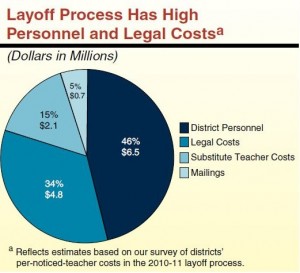California school districts should not be bound by seniority when budget cuts force them to lay off teachers, according to far-reaching report released yesterday by the state Legislative Analyst’s Office.
A Review of the Teacher Layoff Process in California also recommends changing the deadline for notifying teachers they may be laid off from March 15 to June 1, eliminating the teachers’ right to a formal hearing and giving more authority to local districts and bargaining units to determine the layoff process.
The LAO based its recommendations on responses to a survey from 230 out of about 950 school districts, although the Analyst’s Office said those responses included eight of the state’s ten largest districts.

One the main concerns was the huge number of “overnotifications,” or sending pink slips to far more teachers than necessary. According to the LAO, for every ten teachers given preliminary layoff notices last March, about 75 percent of them ended up keeping their jobs.
The problem lies in the timeline, which forces school districts to make budgetary decisions before the governor releases the May Revise, which contains the most current information on projected state revenues. To be on the safe side, districts issue layoff notices based on the worst-case scenario.
The report notes that lowering the number of initial layoff notices “would reduce the time and cost invested in conducting the layoff process, result in fewer teachers unnecessarily concerned about losing their job, and minimize the loss of morale in the school communities affected by layoff notices.”
Union leaders criticized that logic as overly simplistic. Shannon Brown, California’s 2011 Teacher of the Year and president of the San Juan Teachers Association, said moving the deadline for layoff notices may make sense from a fiscal perspective, but would have devastating consequences for laid-off teachers, giving them just a few weeks to find a new job. That’s what contributes to low teacher morale, said Brown. That and the entire crisis in education funding in California that’s led to increasing class sizes, dwindling resources, teacher bashing, and the loss of some 32,000 teaching positions in the last four years. “The layoff notices only add insult to injury,” she said.
The high price of layoffs
It costs districts about $700 for each teacher who’s pink-slipped in the spring. Sacramento City Unified School District, which sent notices to more than 460 teachers last week, estimates the cost at $670 per teacher. That’s $308,000 for a district that’s been cut by $90 million over the past three years. Statewide, California school districts spent about $14 million last year in

administrative and legal expenses, plus the costs of postage and paying for substitutes for teachers who challenged their notices before an administrative law judge.
Typically teachers will ask for a hearing if they believe the district made a mistake in their hiring date or the type of credential they hold; both factors that count when determining who gets laid off. But the LAO concluded that the hearings do not “add substantial value” to the process, and recommended that they be eliminated and replaced with a less formal review process.
San Juan’s Brown countered that the hearings in her district uncover mistakes nearly every year that result in people getting their jobs back. “If hearings were not held,” said Brown, “there would be people wrongfully terminated.”
Asked about the report at the Capitol yesterday morning, State Senate President pro Tem Darrell Steinberg said although he hadn’t had a chance to review it detail, he sympathized with the financial dilemma facing school districts and noted that unless the Governor’s ballot initiative to raise taxes passes in November, the fiscal crisis will become even more severe. At that point, some of the LAO’s recommendations will have to be on the table. “We need to consider an array of options moving forward,” said Steinberg.
That worries the California Teachers Association. Spokesman Mike Myslinski said the LAO’s plan is a misguided effort that fails to address the underlying problem of the state’s inability to balance the budget. “The bottom line,” said Myslinski, “is that the state really is in extraordinary times now, and we want lawmakers to be cautious of using these current dire circumstances to make permanent policy decisions that impact student learning.”